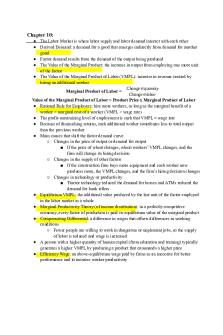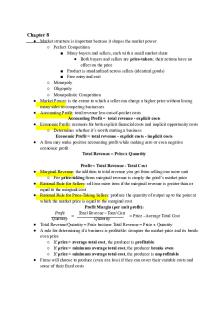Micro Econ Chapter 6 Lecture Notes PDF

| Title | Micro Econ Chapter 6 Lecture Notes |
|---|---|
| Course | Intro To Microeconomics |
| Institution | Indiana University - Purdue University Indianapolis |
| Pages | 4 |
| File Size | 319.8 KB |
| File Type | |
| Total Downloads | 144 |
| Total Views | 289 |
Summary
Chapter 6● Trade can make everyone better off ● Markets reallocate resources ○ Markets create gains from trade by effectively allocating tasks ● Comparative Advantage: the ability to do a task at a lower opportunity cost ○ To find this, compare the opportunity costs for a given good ○ Drives interna...
Description
Chapter 6 ● Trade can make everyone better off ● Markets reallocate resources ○ Markets create gains from trade by effectively allocating tasks ● Comparative Advantage: the ability to do a task at a lower opportunity cost ○ To find this, compare the opportunity costs for a given good ○ Drives international trade ● Theory of Comparative Advantage: it makes sense to produce the things you’re especially good at producing and buy everything else from others ● If a country specializes according to its own comparative advantage and then trades with other nations, it can consume at a higher level than the domestic production possibilities frontier ● The slope of a PPF shows the opportunity cost of a choice ● Ricardian Model: countries will specialize in goods they can produce more cheaply than other countries ○ Straight PPF ● Total production increases with trade ● Absolute advantage does not automatically mean that one party has the comparative advantage ● Factors of Production: land, labor, physical capital, human capital ● Factor Intensity of a good: measure of which factor is used in relatively greater quantities than other factors of production ● Inputs of Production: used up in the production process ● Heckscher-Ohlin Model: a country that an abundant supply of a factor of production will have a comparative advantage in goods whose production is intensive in that factor ● The domestic demand (supply) curve shows how the quantity of a good demanded (supplied) by domestic consumers (producers) depends on the price of that good
Consequences of Imports (below)
● When the economy is opened to international trade, imports enter the domestic market ○ Domestic price declines to the world price ○ The lower price reduces the quantity supplied by domestic sellers and increases the quantity demanded by domestic buyers ○ Imports fill the gap between quantity supplied and demanded ● Domestic consumers gain when they import a good because they pay a lower price
● Domestic producers lose when they import a good because they must lower the price that they charge for their good ● Imports: consumer surplus rises, producer surplus declines, but economic surplus rises
Consequences of Exports (below)
● When the economy is opened to international trade, some of the domestic supply is now exported and ○ Domestic price rises to the world price ○ Higher price increases the quantity supplied by domestic sellers and reduces the quantity demanded by domestic buyers ○ Exports fill the gap between supply and demand ● Domestic consumers lose when they export a good because they pay a higher price ● Domestic producers win when they export a good because they increase the price that they charge for their good ● Exports: producer surplus rises, consumer surplus declines, but economic surplus rises
International Trade
● Tariffs: a tax levied on imported products ○ Pushes up price ○ The government receives revenue with tariffs, but the importer receives the added revenue with quotas ○ Two effects: ■ Increase in domestic production, reduction in domestic consumption ■ Less is consumed, leading to lower gains from trade ● Red Tapes: increases the trade costs ● Import Quotas: a limit on the number of imported goods ○ Has a market effect similar to a tariff but does not raise government revenues...
Similar Free PDFs

Chapter 6 Econ 105 Notes
- 4 Pages

Chapter 6 - Lecture notes 6
- 5 Pages

Chapter 6 - Lecture notes 6
- 6 Pages

Chapter 6 - Lecture notes 6
- 9 Pages
Popular Institutions
- Tinajero National High School - Annex
- Politeknik Caltex Riau
- Yokohama City University
- SGT University
- University of Al-Qadisiyah
- Divine Word College of Vigan
- Techniek College Rotterdam
- Universidade de Santiago
- Universiti Teknologi MARA Cawangan Johor Kampus Pasir Gudang
- Poltekkes Kemenkes Yogyakarta
- Baguio City National High School
- Colegio san marcos
- preparatoria uno
- Centro de Bachillerato Tecnológico Industrial y de Servicios No. 107
- Dalian Maritime University
- Quang Trung Secondary School
- Colegio Tecnológico en Informática
- Corporación Regional de Educación Superior
- Grupo CEDVA
- Dar Al Uloom University
- Centro de Estudios Preuniversitarios de la Universidad Nacional de Ingeniería
- 上智大学
- Aakash International School, Nuna Majara
- San Felipe Neri Catholic School
- Kang Chiao International School - New Taipei City
- Misamis Occidental National High School
- Institución Educativa Escuela Normal Juan Ladrilleros
- Kolehiyo ng Pantukan
- Batanes State College
- Instituto Continental
- Sekolah Menengah Kejuruan Kesehatan Kaltara (Tarakan)
- Colegio de La Inmaculada Concepcion - Cebu











